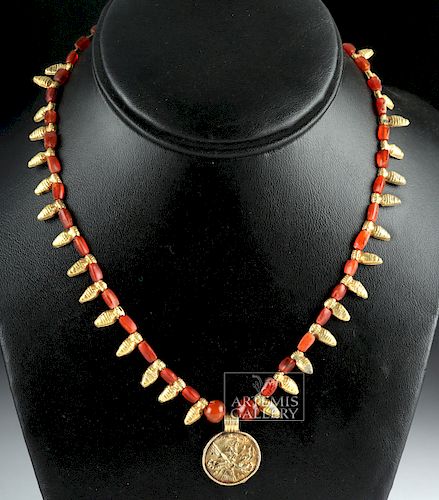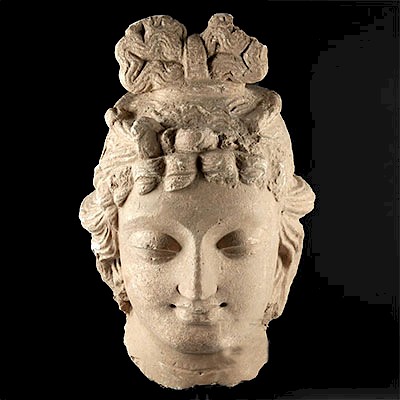Important Achaemenid Gold & Carnelian Necklace - XRF'd
Lot 95
About Seller
Artemis Fine Arts
686 S Taylor Ave, Ste 106
Louisville, CO 80027
United States
Selling antiquities, ancient and ethnographic art online since 1993, Artemis Gallery specializes in Classical Antiquities (Egyptian, Greek, Roman, Near Eastern), Asian, Pre-Columbian, African / Tribal / Oceanographic art. Our extensive inventory includes pottery, stone, metal, wood, glass and textil...Read more
Estimate:
$15,000 - $20,000
Absentee vs Live bid
Two ways to bid:
- Leave a max absentee bid and the platform will bid on your behalf up to your maximum bid during the live auction.
- Bid live during the auction and your bids will be submitted real-time to the auctioneer.
Bid Increments
| Price | Bid Increment |
|---|---|
| $0 | $25 |
| $300 | $50 |
| $1,000 | $100 |
| $2,000 | $250 |
| $5,000 | $500 |
| $10,000 | $1,000 |
| $20,000 | $2,500 |
| $50,000 | $5,000 |
| $100,000 | $10,000 |
| $200,000 | $20,000 |
About Auction
By Artemis Fine Arts
Aug 30, 2018
Set Reminder
2018-08-30 10:00:00
2018-08-30 10:00:00
America/New_York
Bidsquare
Bidsquare : Fine Antiquities / Asian / Ethnographic Art
https://www.bidsquare.com/auctions/artemis-gallery/fine-antiquities-asian-ethnographic-art-3402
Featuring classical antiquities, Asian, ancient and ethnographic art from cultures encompassing the globe, plus fine art. Artemis Fine Arts info@artemisgallery.com
Featuring classical antiquities, Asian, ancient and ethnographic art from cultures encompassing the globe, plus fine art. Artemis Fine Arts info@artemisgallery.com
- Lot Description
Ancient Near East, Achaemenid Persian Empire, ca. 550 to 330 BCE. A stunning necklace of a sublime presentation composed of forty hand-carved, red-orange carnelian beads, six hammered electrum spacer beads near the terminals (83% gold, the fineness of 14K), and thirty amphora-shaped electrum beads. Central to this accessory is a petite electrum pendant with a grooved suspension ring and a shallow, segmented border surrounding a low-relief depiction of Ahura Mazda, the primary deity of creation in Achaemenid Zoroastrianism. The right-facing deity stands with one arm extended atop a sun disc lower body, two pairs of outstretched wings, and a feathered tail representing "Shahbaz," the royal falcon and standard of the Achaemenid Persian Empire. A figure-eight loop caps one necklace strand, and a modern double shepherd's hook clasp hangs from the other. Strung in modern times, this is an opulent and wearable example of ancient history! Size (necklace): 15.75" L (40 cm); size of pendant: 0.75" W (1.9 cm); total weight: 11.6 grams.
Zoroastrianism is one of the oldest religions still in existence and was started by scattered pockets of minority worshippers in the ancient Near East and Central Asia, primarily Iran and India, as a cosmological religion. It was founded on the dualistic concept of good and evil as universal truths, stating that everything in the universe had both positive and negative aspects. Though Zoroastrianism has dozens of lesser deities embodying multiple aspects of the physical world, it is viewed as a monotheistic religion. The primary deity, Ahura Mazda (Ahuramazda, Harzoo, or Ohrmazd), is the deity responsible for creating all that exists within the universe and is the spiritual embodiment of wisdom as well as intellect. Ahura Mazda dictated that the universe should revolve around the power of wisdom, and that it should boldly and regularly influence every action of men and gods (Boyce, Mary. "Zoroastrians: Their Religious Beliefs and Practices." Routledge, London, 2001).
The most prevalent symbolic imagery of Ahura Mazda exists in the "Faravahar," a bust depiction of the deity projecting forth from a solar disk with a broad pair of straight, laterally-extending wings. It is an important symbol of modern Iran as well as the ancient Achaemenid Persian Empire, though it was not always this way. The "Shahbaz" - known as the royal falcon of the king - is told to have lead ancient Near Eastern peoples and the Faravahar to the land of Iran Zamin (Greater Iran) so that a great empire could be established. One of the most powerful individuals to lay eyes on Iran Zamin was Cyrus II of Persia, later known as Cyrus the Great and founder of the Achaemenid Persian Empire. Cyrus the Great was the descendent of several great rulers of fractured Near-Eastern civilizations, so his melding of such ethno-cultural groups into a single cohesive empire was a bold move on an unprecedented scale.
Cyrus the Great decided, in founding the Achaemenid Empire, that the Shahbaz bird would become the standard by which all other nations would recognize his power and influence. The royal falcon was set in gold thread against a red ground surrounded by golden triangles, and the bird would have a prominent head surmounted with a sun disc, extended legs, and a pair of broad wings with curled tips. Larger than a typical falcon or hawk, the origins of the Shahbaz are thought to lie with the golden eagle or eastern imperial eagle of Iran and surrounding Near-Eastern nations.
The importance of this pendant stems from the presentation of the deity Ahura Mazda set above a solar disc with not one but two pairs of wings. The upper set of straight wings represent the Faravahar, and the lower set of curled wings symbolize the Shahbaz. The amalgamation of the two styles of wings interweaves the idea that Zoroastrianism is the moral and ideological foundation of the Achaemenid Empire, and that the Achaemenid Empire acts on said moral and ideological bases. Cyrus the Great completely and unabashedly embraced the teachings of Ahura Mazda, and perhaps considered himself the physical embodiment of the deity's intellect. Cyrus defined the grounds on which laws in his empire were founded, mandated how citizens living under his protection should behave both morally and religiously, and the manners in which said citizens should be punished if any such mandates were violated. Physical depictions of Ahura Mazda with two sets of wings are exceedingly scarce, making this pendant one of unfathomable rarity.
While the quality of the gold components tested at 14K, an X-Ray Fluorescence analysis indicates that the elemental composition of this material is consistent with ancient electrum from this region. The XRF analysis shows the elemental composition to be roughly 83% gold (fineness equal to 14K), 11% silver, and 6% copper.
The electrum components of this piece have been tested using X-Ray Fluorescence (XRF) analysis and have been found to be of the material stated. A full report will accompany purchase.
For a depiction of a four-winged representation of Ahura Mazda, please see The Metropolitan Museum of Art, accession number 1989.281.33: https://www.metmuseum.org/art/collection/search/327422
For a matching earring to the example above, please see the Museum of Fine Art, Boston, accession number 1971.256: https://www.mfa.org/collections/object/earring-155819
Provenance: private East Coast, USA collection
All items legal to buy/sell under U.S. Statute covering cultural patrimony Code 2600, CHAPTER 14, and are guaranteed to be as described or your money back.
A Certificate of Authenticity will accompany all winning bids.
We ship worldwide and handle all shipping in-house for your convenience.
#135444Wearable as shown. Beading and electrum components are ancient. Stringing and hook clasp are modern. Amphora beads have some small pitting holes, hairline fissures, light tarnishing, and slight bending to overall forms, with repairs to four beads, and losses to verso of one. Pendant has slight bending to overall form, light tarnishing, and minor separation of segmented border from disc. Small chips and losses to outer areas of some carnelian beads, with some clouding across exterior.Condition
- Shipping Info
-
All shipping is handled in-house for your convenience. Your invoice from Artemis Gallery will include shipping calculation instructions. If in doubt, please inquire BEFORE bidding for estimated shipping costs for individual items.
-
- Buyer's Premium



 EUR
EUR CAD
CAD AUD
AUD GBP
GBP MXN
MXN HKD
HKD CNY
CNY MYR
MYR SEK
SEK SGD
SGD CHF
CHF THB
THB














